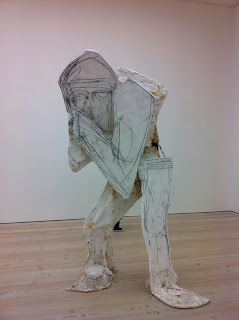Folkert de Jong
Seht der Mensch 2007
New Sculpture
Saatchi Gallery
The heat is on and I am struggling here I sit in my office loft... I don't want to complain though, it is a gorgeous day in London and I am finally back here at my desk to write another post.
The new exhibit at the Saatchi Gallery has been met with the question "Is it any good?". I am questioning the question. Can you actually judge what is good and bad Art? Some of it will resonate with you and some will not. There is perhaps nothing more subjective than Art, and the pleasure of judging is within ourselves.
Kris Martin
Summit, 2009
David Altmejd
The New North, 2007
David Altmejd
The Healers, 2008
Whatever you do think of this exhibit it is entertaining. Each room has a new surprise from the macabre to the destructive, even sexual agony. But, if you are looking for pure beauty I would suggest that you venture another route.
Dirk Skreber
Crash 1&2
Thomas Houseago
Untitled 2000
Thomas Huseago
Figure 2
John Baldessari
Beethoven's Trumpet (With Ear) Opus #133, 2007
Baldessari's piece is fascinating and quite brilliant, it is about the paradox of communication's incomplete nature - a sculptural sound piece about a deaf composer. If you speak into the trumpet a part of Beethoven's six quartets will be heard.
Berlinde de Bruyckere
K36 (The Black Horse)
2003
This piece has a nauseating effect, the artist has stripped the horse of identity.
Roger Hiorns
Copper sulphate Chartres and Copper Sulphate Notre-Dame 1996
(partial)
Folkert De Jong
The Dance (2008)
"The clones are trading with themselves, their own kind, ripping off each other and dancing towards their destiny: self-destruction"
Folkert de Jong
Matthew Brannon
Nevertheless (2009)
"Nevertheless, is an adverb comprised of three words: never-the-less. It became my stance against the panic that ensued from the economic collapse. An attempt to answer the question: what can we make when we shouldn't be making anything?"
Matthew Brannon
Bjorn Dahlem
The Milky Way, 2007
David Batchelor
Parapillar 7 (2006)
Martin Honert
Riesen (Giants) 2007
The German artist Martin Honert creates human figures from a child's point of view. Here is a perspective with me and my youngest son (Marcel). Their 2.72 metres hight is not coincidental but the actual measurements from the tallest man of the 20th century, American Robert Wadlow. We do not know their intention but the word Riesen, do mean "Trek" or "Journey".
With that I am trekking along and wishing you a great evening!
With Love
Kristin
His large-scale human figures manage to capture a vivid immediacy and sense of wonder achieved by recreating the world from a child’s point of view. Instead of looking back from an adult’s nostalgic perspective, the artist bases his works on family photographs and illustrations from schoolbooks, as well as his own childhood drawings, using scale and illusion to "save an image before it dies within me".
A feeling of being afraid in a huge and empty exhibition space originally inspired Honert to make his oversized figures entitled Riesen (which translates as ‘trek’ or ’journey’). The sculpture is composed of two bearded men, dressed in ordinary, contemporary clothing. The fact that they are each 2.72 metres high is not entirely fantastical or arbitrary; Honert took this specific measurement from the tallest man of the 20th century, an acromegalic American named Robert Wadlow.






















































